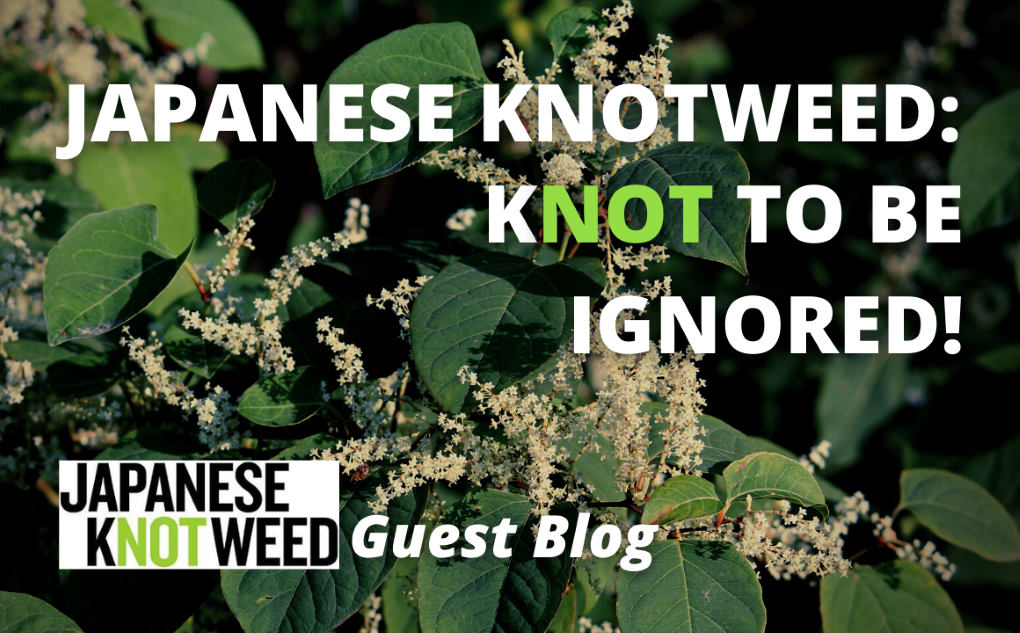Japanese Knotweed: Knot to be ignored!
Japanese Knotweed Identification
Rhizomes (roots)
The rhizomes are the energy store of the plant, allowing it to hibernate over the winter and re-emerge in the spring. These are the most fertile part of the plant: a piece the size of your little fingernail, 0.5g, can propagate into a new plant. Japanese knotweed spreads via rhizome material and not by seed. We only have the female version of the plant in the UK, which means there are no viable seeds. Every infestation of Japanese knotweed in the UK comes from the first cutting that arrived in the UK in 1850 and they’re all genetically identical. As Japanese knotweed can only spread by means of vegetative matter, this means that it spreads via human disturbance.
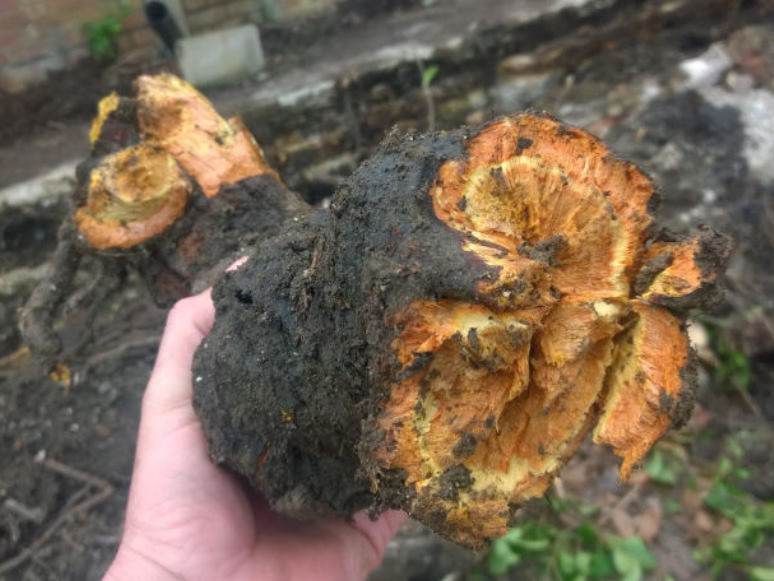
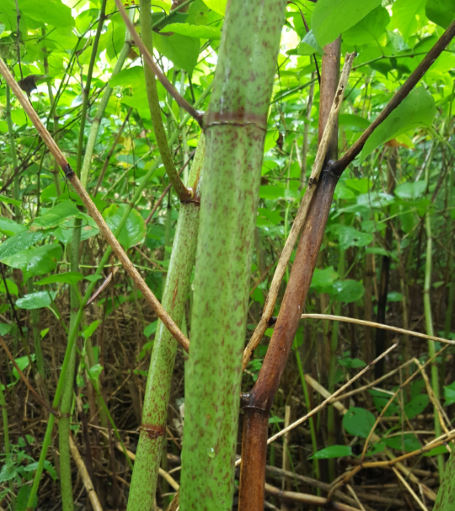
Stems
Leaves
The leaves are shovel shaped and NOT heart shaped, as many websites report. The top of the leaf has a flat edge, and it leads down to a point. They can grow up to around 20cm long (hand-sized).
They turn yellow in November, just like the trees and fall off.
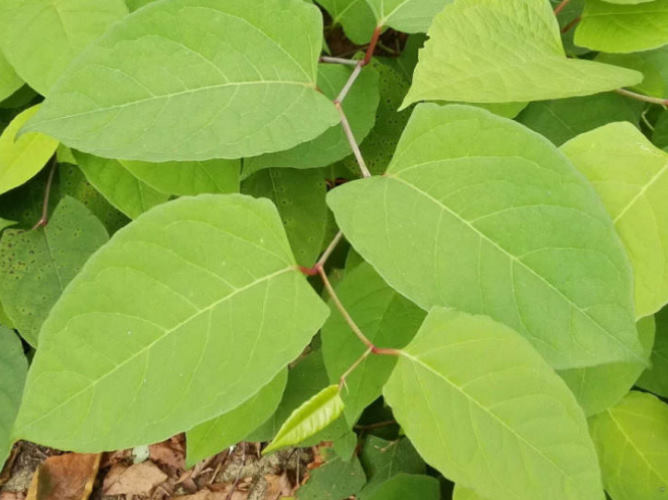
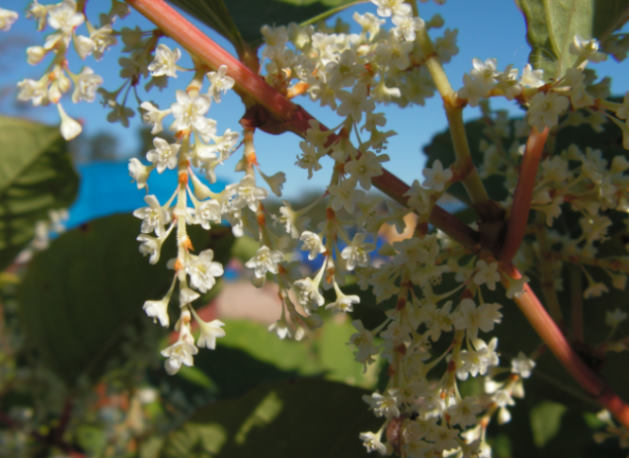
Flowers
The flowers appear from August to mid-September. They’re creamy-white and small, forming a cluster, called a panicle.
Although there are no viable seeds in the UK, as we only have the female version of the plant, Japanese knotweed can hybridise with similar species, such as Giant knotweed and dwarf knotweed to create bohemian knotweeds.
Plants mistaken for Japanese knotweed
Bindweed
This is a creeper, not a free-standing plant like knotweed. It’s commonly found in gardens and is quick growing, spreading quickly as it self-seeds.
It has small leaves with a deep obvious lobed back to the leaf, i.e. heart-shaped, with single trumpet-like white flowers.
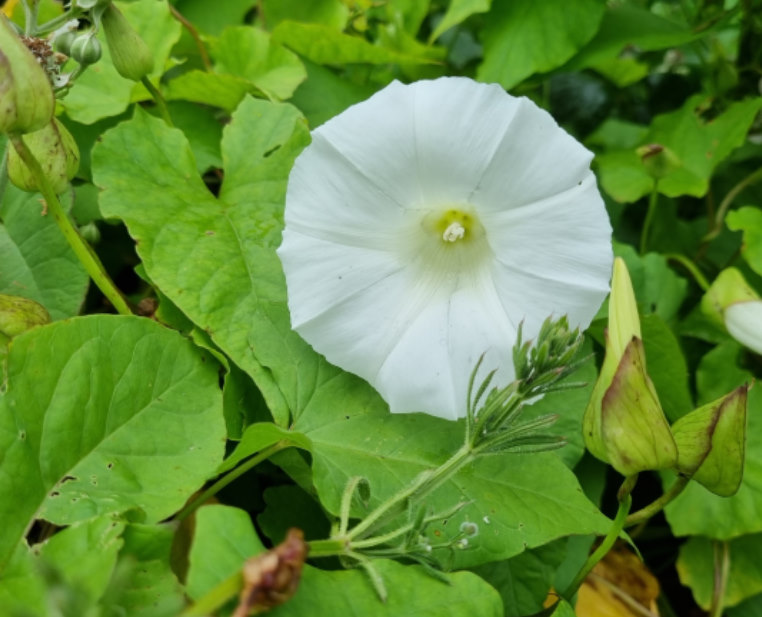
Russian Vine
Commonly called “Mile a Minute”, this is a vining plant with woody, climbing stems that can reach to at least 10m in length.
The dark green leaves are heart-shaped, and the flowers are creamy white and almost cover the plant during summer.
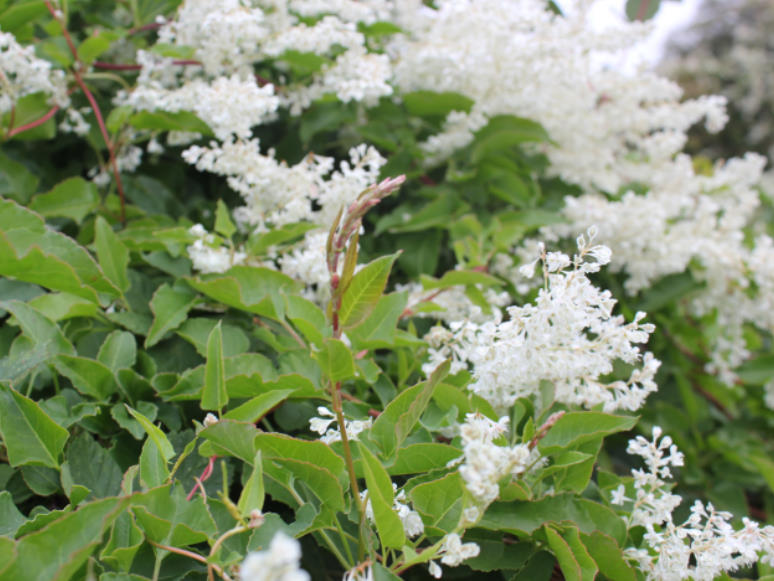
Himalayan honeysuckle
This is a deciduous shrub, growing to 2.5m with cane-like stems and soft, pointed leaves. It’s the plant’s tall free-standing habit that enable it to be confused with knotweed, however its leaves are slenderer with lobed back (not a flat back like knotweed) and the flowers purple (not white like knotweed). Himalayan honeysuckle also has a symmetrical growth habit whereas knotweed has an alternate growth pattern.
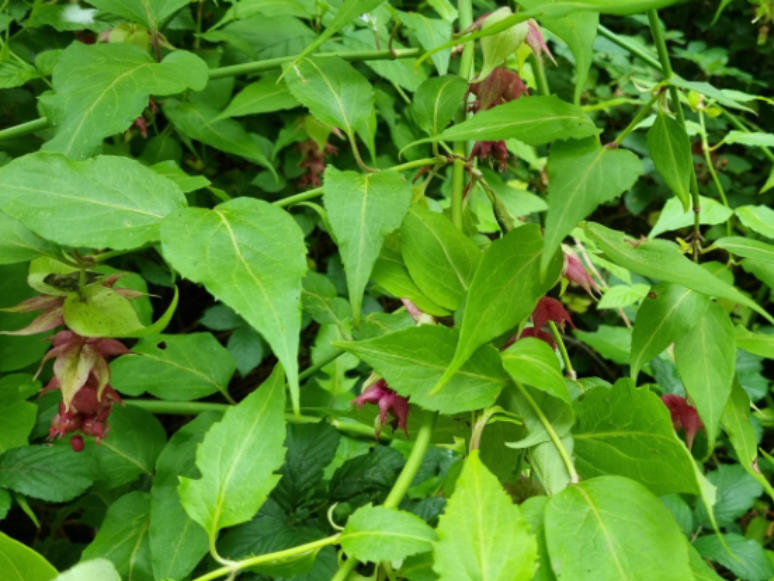
Houttuynia cordata
Houttuynia is a flowering plant native to southeast Asia but is commonly planted as an ornamental plant in the UK. It grows mostly in shady locations and is sometimes mistaken with Japanese knotweed due to the leaf shape, however Houttuynia leaves often have a lobed back (not flat like knotweed). The single four petal white flowers are also different to hanging cluster of white flowers knotweed produces. The key difference if scale. Houttuynia cordata is a shrub forming close to the ground whereas established knotweed is a tall free-standing plant.
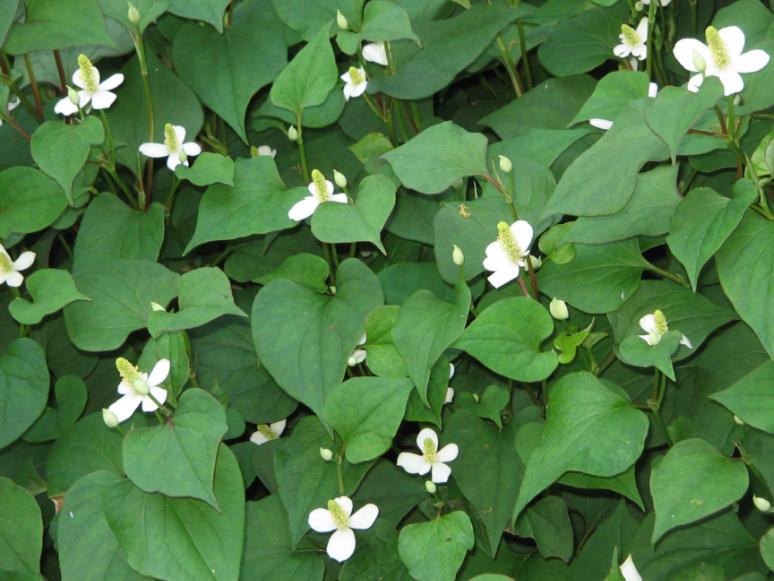
Knotweed and the Law
Private Nuisance
Presence of knotweed on neighbouring Network Rail land caused an actionable claim of Private Nuisance by Williams & Waistell in 2018. The Recorder at first instance found that both properties had been the subject of actual encroachment by knotweed, but neither had suffered any physical damage and therefore there was no actional nuisance. However, it was held that both properties had suffered a devaluation in their market value, because of the continuing presence of knotweed on Network Rails land which was interfering with their quiet enjoyment of their properties. On appeal, the Court of Appeal held that the initial Judgment had been wrong in principle to find that the mere presence of knotweed within 7 metres of the Claimants’ land was an actionable nuisance because it diminished the market value of their properties. However, the Court of Appeal did find that once encroachment has been established, then this would automatically amount to physical damage and an actionable nuisance. They, therefore, upheld the original damages award. Mr Williams was awarded a total of £16,420 whilst Mr Waistell was awarded £14,620
Misrepresentation
The Seller’s Property Information Form (TA6) is part of the Law Society’s National Conveyancing Protocol. The 4th Edition of the form was published in February 2020 and included changes to notes within the form and the explanatory notes which accompany the form. Changes were made to the Japanese knotweed, flood risk, radon and septic tanks sections. Changes to the knotweed section regarding the presence and risks of Japanese knotweed were released in response to the House of Commons Select Committee enquiry into on Japanese knotweed and its effects on the built environment. The Seller is asked the question ‘Is the property affected by Japanese knotweed?’, to which they must answer carefully from three options:
- ‘Not Known’, if unsure that knotweed exists above or below ground or whether it has previously been managed on the property’.
- ‘No’, only if certain that no rhizome (root) is present in the ground of the property, or within 3 meters of the property boundary even if there are no visible signs above ground.
- ‘Yes’, when they are aware of the presence of knotweed affecting the property. Here they are prompted to provide copies to the buyer of any knotweed management plan and evidence of insurance cover relating to the plan.
If the vendor lies and ticks “No” when they know that the property is affected and this can be subsequently proven by the buyer, the vendor can be sued for Misrepresentation.
Professional Negligence
Conways Chartered Surveyors failed to identify Japanese knotweed during a Level 3 Building Survey giving rise to a claim of Professional Negligence against them. Expert evidence at the trial identified that the knotweed should have been clearly visible during the survey. Being found negligent, Conways were ordered to pay £50,000 in damages, which included treatment and residual diminution in value of the property.
ASBO
In 2018, Bristol City Council prosecuted MB Estate Ltd for failing to control the spread of Japanese knotweed. The council had served the property owner with a community protection notice in May 2017, but after no attempt was made to comply with the notice, the council prosecuted the property owner using the Anti-Social Behaviour, Crime and Policing Act 2014.
Japanese Knotweed & UK Law
Do’s and Don’ts of Japanese Knotweed
If you suspect you’ve found knotweed on a property, don’t…
Ensure that you do….
Japanese Knotweed Treatment & Removal
Excavation
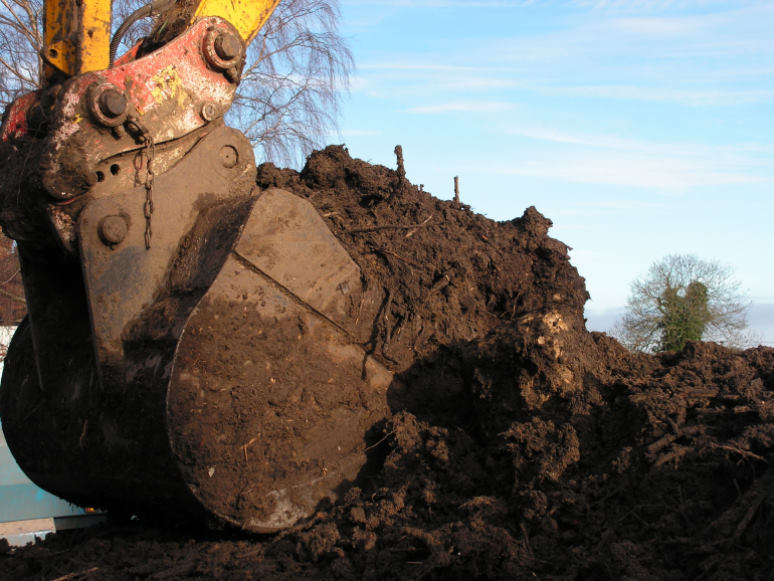
Knotweed Excavation is the only way to achieve complete Japanese knotweed removal. All Japanese knotweed growth is removed, including the root system (rhizomes) and all contaminated soil.
Root barrier is used to prevent the spread or to lock in ground containing knotweed plant material.
Chemical/Herbicide Treatment
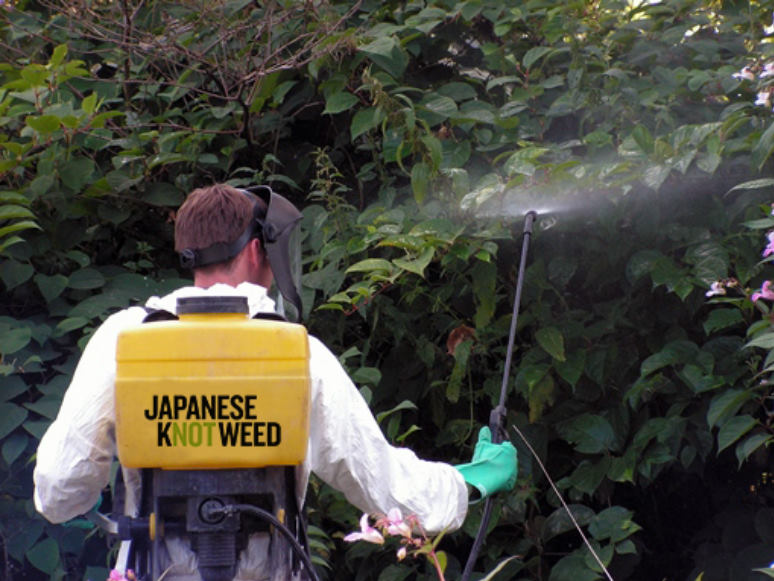
Chemical Treatment (herbicide) will not remove Japanese knotweed but will help control its growth. Japanese knotweed treatment will exhaust the plant’s energy stores. Over time, the treatment programme will prevent the plant producing aerial growth and additionally, prevent the rhizomes from growing further. If the knotweed area is likely to be disturbed, physical removal of the knotweed may be required instead. Treatment methods include stem injection, herbicide spray and leaf wiping. Our herbicide programmes are packaged within a 10-year Knotweed Management Plan (KMP), which comes with an Insurance Backed Guarantee.
About Japanese Knotweed Ltd
Japanese Knotweed Ltd (JKL) is a private limited company, founded in 2010. Currently employing over 50 staff including field operating surveyors, managed via 3 offices situated in London, Southampton, and Manchester. We work throughout England, Wales and Scotland for construction companies, developers, facilities management, housing associations, local authorities, property maintenance and private property owners.
Guest article by Japanese Knotweed Ltd, experts providing surveys, treatment, removal, legal assistance & reports, guarantees and insurance.
* * *
Would you like to receive our monthly Newsletter?
Sign up for our monthly Newsletter for helpful articles and regular industry updates. We promise not to spam you with hundreds of emails and you can unsubscribe at any time.


